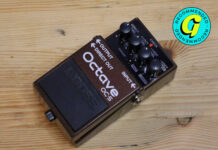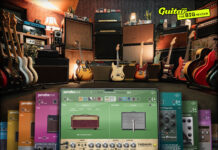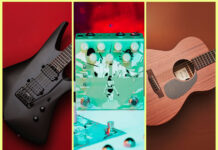
Interview: White Denim are making the old new again
The Austin music scene is a wellspring for creative guitar music – from grizzled bluesmen of the 70s and 80s to the hip young things showcased at South By Southwest, the Texan capital has remained the place to go to get noticed. That was certainly the case when White Denim were starting out in the city back in the mid 2000s, though as frontman and guitarist James Petralli recalls, the band’s raw, lo-fi sound wasn’t exactly in vogue at the time.
“The Killers were really big and everybody was trying to sound like Interpol,” James tells us. “And Austin, it felt like people were moving there, as we had, to make some kinda move – to play South By Southwest and so on. There was this kind of a trendy business-forward kind of approach to making music that we saw a lot… but our idea was to be really loud and obnoxious, and very different from the bands who did single-note, fourth-generation Joy Division rip-off stuff!
“We didn’t really feel like we belonged in that scene – none of us wanted to put a stripe of makeup on one cheek or whatever, which was the trend at that time! We were like: ‘Hey man, we’re blue-collar guys, and we wanna be really good at this, and we don’t wanna sound like the Killers!’”
Faking it
If White Denim have always epitomised honesty and individuality ahead of trend-chasing, James’s guitar-playing journey didn’t start on such an authentic note. “I can remember starting to lie about being a guitar player, right around the age of 14 or 15!” James laughs when we ask about his early musical experiences. “I had this friend, Andrew who was a guitar player, and I remember telling him: ‘Yeah, I got a guitar for Christmas…’ and he kept wanting to come over. But every time he’d come over I would lie and say, ‘Yeah, uh, the guitar’s being worked on… it’s in the shop!
“I thought that Marty McFly was really cool – I kind of bought in to the whole ‘cool guy plays guitar’ thing, way before I started playing. I had this biography of Buddy Guy, and I would go around holding it cover out, so people knew I was into guitar! It was definitely about wearing it before it was about the actual playing! And it was research – listening and reading about The Yardbirds and all those guys.”
The research would eventually pay off when a 17-year-old James saved up enough cash from his part-time job to buy himself an Epiphone Casino. “I was like, ‘Yup, that looks like the 345 Marty McFly played!’” James quips, but by this point, he was also heavily informed by the classic guitar music he’d immersed himself in. “I was really into The Beatles, and it was the ‘rooftop concert’ guitar as well. So I promptly removed the pickguard and played Bad To The Bone and Malagueña for hours and hours on end!
“Pretty much right after I got that Epiphone Casino, I met Josh Block, our first drummer. He’d just finished his first year of Jazz Studies at UNT, so he was already a monster drummer. I met him at his band’s rehearsal, because someone who he was playing with sold nickel bags!
“So I walked in, and I guess he must have thought I was cool, because he played like some extravagant fill on some Dave Matthews Band song that he was rehearsing with this cover band. So I stuck around, and we talked about records and became friends and started playing together.”
Hanging out with Block coincided with James developing an interest in free jazz, and the two events gave the young guitarist the chance to experiment musically with top-notch players, even if he wasn’t entirely sure of what he was doing…
“No offence to that process, but I didn’t get it!” he admits. “A lot of it seemed like avant garde and noisy, and it didn’t make a lot of sense to me. But in that, I felt really freed to play, and do it with musicians who were miles beyond where I was, and call it free jazz! Eventually, I figured out how to play, but that was kind of like my foot in the door – talking about cool shit, and making weird noises with guitar!”
Faded denim
Petrali and Brock worked on various projects together, before teaming up with bassist Steve Terebecki to become make a bluesy psychedelic racket as White Denim in 2006. The trio became a quartet with the addition of second guitarist Austin Jenkins and built serious momentum on the back of critically lauded and commercially successful albums D and Corsicana Lemonade. Then in 2015, Block and Jenkins unexpectedly quit the band, leaving the guitarist and bassist to carry on alone.
To James and Steve’s credit, White Denim have hardly missed a beat – releasing three albums in four years, with both 2016’s Stiff and 2018’s Performance appearing in the UK album charts, all while the duo were backed up by a revolving cast of studio and touring musicians.
As anyone who’s listened to the dying embers of The Clash on record will probably attest, working with an intentionally malleable line-up isn’t always the most creatively stimulating environment, but James has found the opposite is true.
“Everybody has their strengths and their interests, and all that impacts the music that we’re making,” he insists. “There’s a guy that was in the band for awhile named Mike St. Clair, who I’m meeting with later. He’s not in the stage band anymore but I have a tune that I could really use his ears on. It’s helped me to open my ears up to other musicians and other techniques. It just made us more connected and better musicians by having different people in, and different voices in the room.
“Our goal is to make something as good as it can possibly be before we give up on it! [laughs] We always want to unanimously like a piece of work. So I think that between the people who have been involved in the project, we have sometimes four, five or six people weighing in and you can kind of get a sense of whether or not it’s a good thing by the time you’ve reached hour 60 of working on a piece of music!
“I think it’s just diligence and just being okay with failing. In those early stages, knowing that we’re going to find a way to make a good thing together. We like doing it. We have our own studio, so it’s low pressure, and we trust each other’s tastes.”
Back to the future
The latest fruit of this process is Side Effects – an album that’s largely been created by James and his collaborators going back into the archives and re-examining offcuts from previous albums, and reshaping these ‘side effects’ and making them into something cohesive and fresh.
“Having had our own studio since the early days means there’s just as much music that hasn’t been released as has been,” James explains. “It’s partly because we don’t want to give up on something that might not be working immediately. And because we’ll try to generally cut about 15 songs in one go, things can get put aside – not necessarily because they’re not good pieces of music, but because there are like seven songs that obviously really work together.
“The side effect of that is that we have these leftover songs that were kinda outliers from the last three records. I think we had six or seven that felt like they could be a record, and so we’re like, ‘Let’s write a couple of new songs that provide further context to this’.”
As befits an album that draws from a wide array of different moments and eras of the band, the songwriting process varies dramatically from track to track. “Shanalala was fully demoed out,” James explains. “if you played my demo, which is just me, versus the studio recording, there are better drums and a better bass part, but it’s still pretty much the same. But we’ll also write together in the studio. If somebody has a single riff or a set of changes, we’ll play on it and develop it together. Whatever it needs to get across the finish line, we’ll do it – there’s no set process for this band.”
The aforementioned Shanalala is the album’s lead single, and while it arrived fully formed, it had been sat on ice for the better part of six years, in no small part due to its unconventional birth…
“I got a SP-404, one of those Roland samplers, when we were touring Corsicana Lemonade [2013],” James recalls. “We’d hook it up to the car stereo and I’d ask for a song from each guy in the band, and then I’d take little samples from each song to try and make something in the course of an hour and then play it back for the guys. So with Shanalala, I was just getting to know what that machine could do. So I kind of dumped a bunch of drum samples from this iPhone app into the machine, and I can’t even remember what songs I had in, but the whole process started with a mashup/remix-y kind of approach.
“But having just made Corsicana Lemonade – a record where we wanted to sound like Little Feat – going into that mode was not a unanimous thing for us at the time! It was like, ‘Yeah, that’s funny James, but we’re not going to make that record right now…’”
Hollow pursuits
If White Denim’s sound, line-up and general approach to making music seems to constantly be evolving, James’ choice of guitars has stayed relatively consistent with the boy who was captivated by Marty McFly all those years ago.
“For the last year, I’ve been playing this early 70s ES-335,” James says. “I got a stereo 335 and I’m loving it, and I was just shopping for a 345 of the same generation, because they’re a little less expensive. I also have a 330 with a Maestro Vibrola on it, and an old 50s SG with that vibrato system, too – I just love the Maestro for recording, that really quick vibrato that you can do with it. There’s nothing else like it.”
Despite the sonic advantages in the studio, however, using the Maestro in such a way does have its drawbacks in the live environment. “I’m not touring with an instrument that has a vibrato, but if I did I could lose three pedals probably!” James exclaims. “We do these long medleys, playing for 20 or 30 minutes without stopping and that’s not really conducive to using a bar with tuning and that kind of stuff. In the past couple of years, I’ve used an MXR Phase 90, and one of those Chase Bliss Warped Vinyl pedals, kind of in lieu of having to have the bar constantly engaged.”
Another lesson learned from the live environment is that using fully hollow guitars on high-volume stages can be problematic, to say the least… “It’s going to be bad!” he jokes. “I use pretty small amps, generally. But the first vintage amp that I got was like the ‘Austin Special’. When you show up in Austin, you get a Fender Stratocaster and a Silverface Twin! That’s exactly what I got when I moved here, but I didn’t have the Strat.
“So I spent a year and a half looking at frowning sound guys who are just like: ‘What are you doing…?! The wah-wah is how you get a boost?!’ I had a really unpleasant guitar combination – like a super-spiky tone. But then I thought, ‘I don’t wanna be their enemy the minute I walk in,’ so I kicked the volume back, and I realised that I didn’t really need a Twin! Then I started getting into these Silvertones – the Sears amps – and I ended up getting four or five of those things so that I’d always have one on the road.
“Nowadays, the Supro Thunderbolt is probably my go-to amp, but I also like the Valco Gretsch stuff – the Pro Bass with a 15, which is essentially a Thunderbolt, and the Gretsch Dual Twin, which has two 10s. Mike Bloomfield used those, and those Butterfield [Band] records are fuckin’ incredible.”
Despite his vintage obsessions in the studio, James keeps things suitably blue-collar when it comes to the road, and if things get a little wild… that’s not always a bad thing. “On stage, I use like a Blues Junior or an AC30. You know the AC30 will cook, but I use different preamps in front of the amplifiers to get most of the grit for stage stuff, so I don’t have to worry about feedback. That said, I do like feedback occasionally! Just that point where it’s about to take off and be unplayable is where I like to live as a guitar player, but singing when you’re trying to wield that can be a little tricky!”
Older and wiser
With over a decade in White Denim’s rear-view mirror, we can’t help but wonder whether all the changes to the band both in terms of personnel and sound has changed their attitude to making music and being musicians. Yet James is adamant that they remain true to the blue-collar ideals they started out with.
“Y’know, I think the main goal remains the same,” he stresses. “We’re working on becoming better players and better writers. We still like the same stuff that we always have. We don’t really follow fashion so to speak – we’re always finding new music, new techniques, new sounds and all that kind of stuff. We just have our own interests, and the commercial viability of a song or a record is often like the fourth thing that we talk about when making something!
“So yeah, it’s pretty much still the same. We’re not quite the assholes we used to be, but I think that’s probably just getting older!”
White Denim’s new album, Side Effects, is out now on City Slang.
The post Interview: White Denim are making the old new again appeared first on Guitar.com | All Things Guitar.
Source: www.guitar-bass.net











